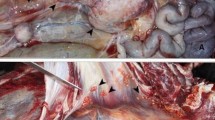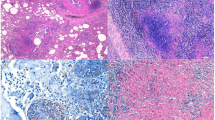Abstract
Eurasian wild boar (Sus scrofa) is widespread in the northern third of Morocco, Northern Africa. We aimed to investigate the presence of Mycobacterium bovis infection in wild boar and to generate information on the possible host status in this region. M. bovis was isolated in six of 43 wild boars. Culture-positive samples yielded spoligotype number SB1627. Sixty percent of lung tissue specimens or tracheobronchial lymph node samples yielded positive culture. Two thirds (64 %) of the wild boar submitted for histopathology revealed tuberculosis-compatible lesions. These lesions were particularly frequent in lymph nodes (63 %) and in lung tissue samples (43 %). Ziehl-Neelsen staining did not identify acid-fast bacilli, indicating paucibacillary infections. Our results confirm the presence of Mycobacterium tuberculosis complex (MTC) infection in Moroccan wild boar. Regarding the host status of wild boar in this region, the often generalized lesion pattern suggests a possible role of wild boar as a component of the MTC maintenance host community. However, our information was limited to 43 wild boars from one specific region. Thus, further research is needed to assess the host status of wild boar in Morocco.
Similar content being viewed by others
Avoid common mistakes on your manuscript.
Introduction
Animal tuberculosis (TB) is due to infection with Mycobacterium bovis and other closely related members of the M. tuberculosis complex (MTC). Globally, TB is relevant for public health (mainly in developing countries), conservation (when it infects endangered species), and animal health and production, since it causes severe economic losses to the livestock industry (Gortázar et al. 2015). In Morocco, northern Africa, bovine TB is endemic with 33 % of dairy cattle farms infected with MTC, countrywide (FAO 2004), and an annual average of 10,000 cases of bovine TB reported in slaughterhouses (ONSSA 2013). In a cross-sectional survey in Morocco, 23 % of the 79 MTC strains from humans were M. bovis (Bendadda et al. 2003). Wild fauna TB in Morocco is not well documented.
Multiple domestic and wild mammals can act as MTC reservoirs (Mukundan et al. 2015). Among them, pigs and their wild ancestor, the Eurasian wild boar (Sus scrofa) have often been implicated in MTC epidemiology (Gortázar et al. 2015). However, wild boar and feral pigs can be maintenance hosts or spillover hosts depending on the environmental context. In New Zealand, for instance, a low proportion of feral pigs displayed severe lesions and abundant epidemiological information suggest that these pigs do not maintain MTC circulation (Nugent et al. 2015). By contrast, wild boar from the Iberian Peninsula and pigs from other geographic regions are regarded as MTC maintenance hosts (Naranjo et al. 2008; Gortázar et al. 2015). In Spain, links between dry summer months and increased TB prevalence have been reported (Vicente et al. 2013).
Wild boars are widespread in the northern third of Morocco, and damage to agriculture and road traffic has recently increased. A total of 12,225 wild boars were harvested by hunters in the season 2012–2013 (HCEFLD 2014). Hence, given that Morocco is characterized by extremely dry summers, bovine TB is widespread, and suitable wildlife reservoirs are present in the country, we aimed to investigate the presence of MTC infection in wild boar and to generate information to elucidate the possible host status of wild boar in this region.
Material and methods
Between 2009 and 2011, TB suspect cases in wild boar were investigated at the Department of Veterinary Pathology and Public Health at Hassan II Institute of Agronomy and Veterinary Medicine in Rabat, for histopathology and bacteriology analyses. A total of 43 hunted wild boars were necropsied in the field, in the northern cork oak (Quercus suber) forest of Morocco (33°9´N, 6°7´E), by local veterinary practitioners, during hunting legal seasons between 2009 and 2011. During necropsies, organs with macroscopic TB-compatible lesions were selected and harvested.
Wild boars were subdivided into three age classes including 16.3 % yearlings (<1 year), 27.9 % sub-adults (1 to 2 years), and 55.8 % adults (>2 years). The sex ratio was evenly divided. Percentage of sampled tissues included mandibular and tracheobronchial the lymph nodes (25 %), lung (24 %), spleen (22 %), liver (20 %), tonsil (5 %), and 4 % of other tissues including the kidney, muscle, and a hock joint capsule. No detailed information about distribution and size of lesions was provided.
A total of 161 tissue samples corresponding to 43 wild boars were provided for a routine diagnosis activity without a pre-established consensus about sampling process. Microbiology was performed on 50 samples from 17 individuals. After decontamination with NaOH, culture was attempted on Herrold and Lowenstein Jensen media for a maximum of five months. Acid-fast bacilli were confirmed by Ziehl-Neelsen staining of any compatible colonies. Mycobacterium sp isolates were identified by PCR and spoligotyping.
A total of 111 tissue samples from 33 wild boars, fixed in 10 % neutral-buffered-formalin, were processed for histopathological examination by paraffin-embedding standard methods. Five-micrometer-thin paraffin sections were stained with hematoxylin and eosin (H&E) and Ziehl-Neelsen stains.
Eight wild boars were subject to both histopathology and mycobacteriology analyses.
Results
M. bovis was isolated in 6 of 17 wild boar (Table 1). All 13 culture-positive samples were confirmed as MTC by PCR. Samples from 6 individual wild boar yielded spoligotype number SB1627 (binary pattern 1101111101111110111101111111111111010100000). Regarding the thoracic region, 60 % of thoracic samples provided, including lung tissue or tracheobronchial LN samples, yielded MTC isolates.
Two thirds (64 %) of the wild boar submitted for histopathology revealed TB-compatible lesions (Table 2). Sixty-three and 43 % of individual wild boar showed TB-compatible lesions, respectively, in lymph nodes and in lung tissue samples. A remarkable 19 % of the sampled wild boar showed TB-compatible liver and spleen lesions. The single hock joint capsule sample revealed TB-compatible granulomas. Typical histopathological TB lesions consisted of granulomas with a caseous necrotic center surrounded by a rim of epithelioid macrophages, lymphocytes, and few Langhans giant cells. These granulomas were associated with moderate to severe fibrosis. Ziehl-Neelsen stains did not detect the presence of acid-fast bacilli, indicating paucibacillary infections.
Discussion
Our results confirm the presence of MTC infection in Moroccan wild boar. Regarding the host status of wild boar in this region, the often generalized lesion pattern suggests a possible role of wild boar as a component of the MTC maintenance host community. However, our information was limited to only 43 wild boars from one specific region. Thus, further research is needed to assess the host status of wild boar in Morocco.
A large proportion of the studied Moroccan wild boar (43–60 %) had TB-compatible lesions or MTC-positive culture from the thoracic region, suggesting a possible excretion of mycobacteria. This figure is similar to those reported from Mediterranean habitats of the Iberian Peninsula (57 %; Martín-Hernando et al. 2007), and higher than figures reported for regions were wild boar (or feral pigs) are not regarded as MTC reservoirs like Atlantic Spain (Muñoz-Mendoza et al. 2013) or New Zealand (Nugent et al. 2015). Of the known risk factors driving TB prevalence in native wild boar populations (Vicente et al. 2013), dry summers are clearly present in the study region. This could perhaps contribute to explain the high proportion of wild boar with generalized TB recorded in this study.
Since all samples were submitted to the laboratory by veterinary practitioners, this material was most likely biased towards animals showing visible lesions. Hence, prevalence estimations are not representative of the whole population. Similarly, the absence of a growing prevalence through age-class may be due to this sampling bias towards visible TB cases. However, the proportion of organs affected and lesion severity were of interest for assessing the possible epidemiological role of wild boar in MTC maintenance in the study region.
Results reported herein are relevant since there are no previous reports on wildlife TB in northern Africa. Although we found no match with the human MTC isolate spoligotype patterns reported in Morocco (Lahlou et al. 2012), our findings are of relevance in a country with a still high proportion of human TB due to M. bovis (Bendadda et al. 2003). Although we cannot confirm the host status of wild boar in the study region, this study confirmed that MTC is circulating among this wildlife host, and that the lesion distribution and lesion characteristics are compatible with excretion and eventual intra- and inter-species transmission. This is important for animal health policy as it adds to the community of suitable MTC hosts in the region. Furthermore, these findings could have relevance for conservation, for instance if endangered TB-susceptible species such as the Barbary lion (Panthera leo) were exposed to infected wild boar, even in captivity (Black et al. 2010).
References
Gortázar C, Che Amat A, O’Brien DJ (2015) Open questions and recent advances in the control of a multi-host infectious disease: animal tuberculosis. Mammal Rev 45:160–175
FAO (2004) TCP/MOR/2904 « Stratégie nationale de lutte contre la tuberculose bovine » In Principales réalisations depuis l’ouverture de la représentation de la FAO à Rabat en 1982. FAO 2011:36–37, 978-925-206938-6
ONSSA (2013). Maladies animales au Maroc: Situation sanitaire en 2013. http://www.fao.org/fileadmin/user_upload/remesa/docs/REMESA/Tunis_Atelier_cloture_Novembre_2013/Maroc_SITUATION.pdf
Bendadda O, Berrada J, Zizi M, Alaoui MA, Remmal A (2003) Tuberculose humaine à Mycobacterium bovis au Maroc : Enquête bactériologique. Animalis 2003 2(1):28–33
Mukundan H, Chambers M, Waters R, Larsen M (2015) The Many Hosts of Mycobacteria - Tuberculosis, Leprosy and other Mycobacterial Diseases of Man and Animals. Edited by, CABI, NY, 2015 / 580 Pages
Nugent G, Gortazar C, Knowles G (2015) The epidemiology of Mycobacterium bovis in wild deer and feral pigs and their roles in the establishment and spread of bovine tuberculosis in New Zealand wildlife. N Z Vet J 63:54–67. doi:10.1080/00480169.2014.963792
Naranjo V, Gortazar C, Vicente J, de la Fuente J (2008) Evidence of the role of European wild boar as a reservoir of Mycobacterium tuberculosis complex. Veterinary Microbiol 127:1–9
Vicente J, Barasona JA, Acevedo P, Ruiz-Fons JF, Boadella M, Diez-Delgado I, Beltran-Beck B, Gonzalez-Barrion D, Queiros J, Montoro V, de la Fuente J, Gortázar C (2013) Temporal trend of tuberculosis in wild ungulates from mediterranean Spain. Transbound Emerg Dis 60(Suppl 1):92–103
HCEFLD (2014). Press Release of May 26th, 2014. http://www.eauxetforets.gov.ma/fr/contenu.aspx?detail=yes&Rubrique=9&id=1219
Martín-Hernando MP, Höfle U, Vicente J, Ruiz-Fons F, Vidal D, Barral M, Garrido JM, de la Fuente J, Gortázar C (2007) Lesions associated with Mycobacterium tuberculosis complex infection in the European wild boar. Tuberculosis 87:360–367
Muñoz-Mendoza M, Marreros N, Boadella M, Gortázar C, Menéndez S, de Juan L, Bezos J, Romero B, Copano MF, Amado J, Sáez JL, Mourelo J, Balseiro A (2013) Wild boar tuberculosis in Iberian Atlantic Spain: a different picture from Mediterranean habitats. BMC Vet Res 9:176, http://www.biomedcentral.com/1746-6148/9/176
Lahlou O, Millet J, Chaoui I, Sabouni R, Filali Maltouf A, Akrim M, El Mzibri M, Rastogi N, El Aouad R (2012) The genotypic population structure of Mycobacterium tuberculosis complex from Moroccan patients reveals a predominance of Euro-American lineages. Plos One 7(10):47113
Black S, Yamaguchi N, Harland A, Groombridge J (2010) Maintaining the genetic health of putative Barbary lions in captivity: an analysis of Moroccan Royal lions. Eur J Wildl Res 2010(56):21–31
Acknowledgments
We thank veterinarians for providing wild boar samples. This is a contribution to the Spanish MINECO grant AGL2014-56305 and FEDER.
Author information
Authors and Affiliations
Corresponding author
Ethics declarations
Conflict of interest
The authors declare that they have no conflict of interest.
Ethical approval
No animal was killed for the purpose of this study. All applicable international, national, and/or institutional regulations were followed.
Rights and permissions
About this article
Cite this article
El Mrini, M., Kichou, F., Kadiri, A. et al. Animal tuberculosis due to Mycobacterium bovis in Eurasian wild boar from Morocco. Eur J Wildl Res 62, 479–482 (2016). https://doi.org/10.1007/s10344-016-1022-0
Received:
Revised:
Accepted:
Published:
Issue Date:
DOI: https://doi.org/10.1007/s10344-016-1022-0




